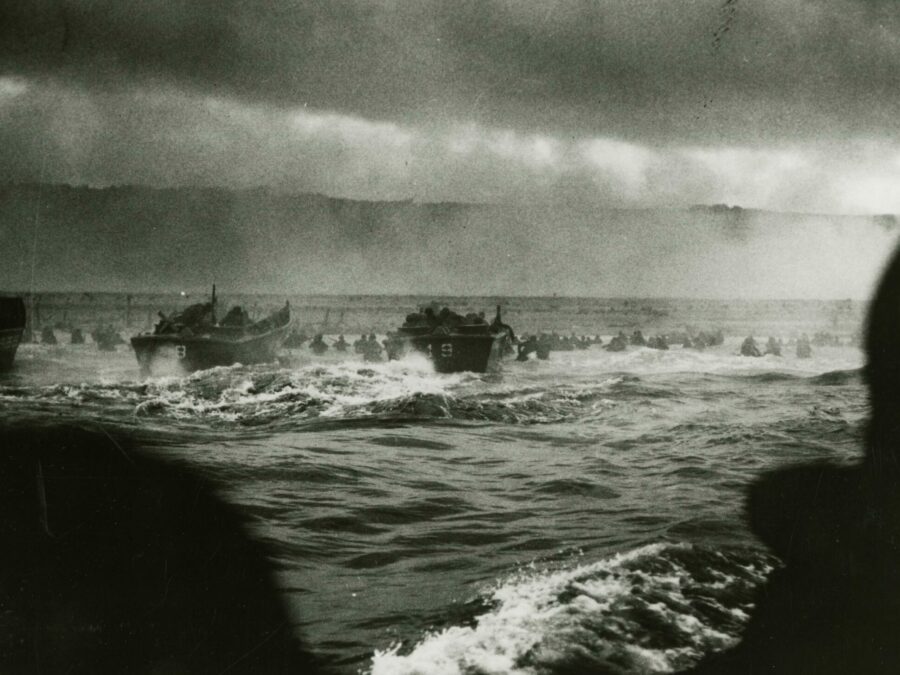
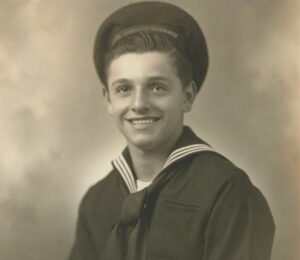
On the 70th anniversary of D-Day, the invasion of Normandy, NBC’s Tom Brokaw was at Omaha Beach and interviewed World War II veteran Frank DeVita who shared memories of his participation in D-Day. He reflected on those who lost their lives and were laid to rest in the cemetery above Omaha Beach, “Those are heroes, those are my heroes.” When Brokaw asked about the lesson for the generations of DeVita family members that have accompanied him, DeVita emotionally replied, “Love your Freedom, because that’s what we fought for. We fought for the Freedom.”

This story describes Frank Joseph DeVita’s utmost respect and deep appreciation for those he served with shoulder-to-shoulder during the war. Born in Brooklyn, New York, on May 15, 1925, DeVita was the third of four children of Daniel and Elizabeth DeVita. Frank was only 16 when the Japanese attacked Pearl Harbor on Dec. 7, 1941, and the next day, the United States declared war on the Empire of Japan, and in subsequent days on Germany and Italy. Like so many his age, DeVita wanted to serve; however, at only 16, he required his mother’s signature to enlist, which she declined to do until he finished high school. Two years later, having enough credits to graduate, DeVita left high school early, and on Aug. 14, 1943, enlisted in the U.S Coast Guard Reserve. One week later, he reported for active duty as an apprentice seaman to Coast Guard Training Station, Manhattan Beach, Brooklyn, New York.
On Dec. 2, 1943, DeVita was assigned to the Coast Guard-manned transport USS Samuel Chase (APA-26). The Chase was a 489-foot attack transport, which he served aboard for 27 months and 19 days until transferred ashore on March 21, 1946. During World War II, Samuel Chase participated in all five of the major amphibious operations in the European Theater, including Algiers in late 1942, followed by Sicily, Salerno, Normandy, and Southern France, before sailing for the Pacific Theater in 1945. It was following the Salerno invasion that DeVita reported aboard the Chase.
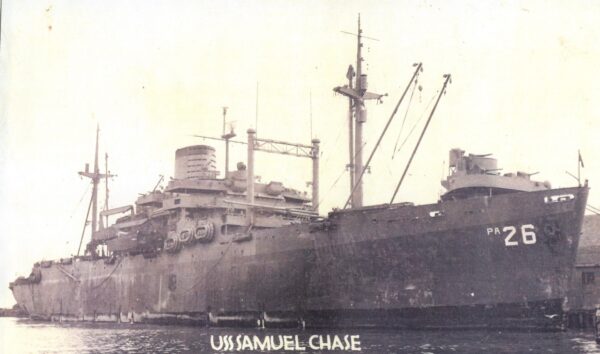
During both the Normandy and Provence campaigns of the Liberation of France, DeVita crewed a Higgins boat landing craft (LCVP) on repetitive landings, with the task of lowering the LCVP’s forward ramp. On D-Day, his Higgins boat, was part of the first wave, making 15 trips onto Omaha Beach at Normandy, to ferry troops to the fight, and return with wounded and dead. His Coast Guard service record contains entries noting meritorious conduct during the initial assault landings at Omaha Beach on June 6, 1944, and during the landings on the southern coast of France from Aug. 15 to 16, 1944. The Chase stood duty at Okinawa in the aftermath of the U.S. Army and Marine Corps victory in the largest amphibious assault in the Pacific Theater, coming under frequent air attack before delivering occupation troops to Japan and repatriating U.S. troops to the U.S. through 1946. DeVita was honorably discharged from the Coast Guard on April 3, 1946.
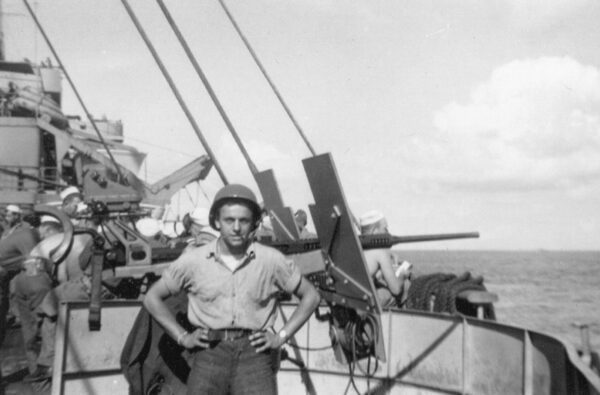
Marking the 75th anniversary of D-Day, DeVita penned his D-Day story “To Hell and Back” for the June 2019 issue of Columbia, the monthly magazine of the Knights of Columbus. On June 6, 2019, Frank and 75 family members returned to Normandy to honor the 75th anniversary of D-Day, where he was joined by the Coast Guard’s 26th Commandant, Admiral Karl Schultz, and a small contingent of “Coasties,” including a C-130 crew participating in the D-Day ceremony overflight.
The following are excerpts from DeVita’s D-Day story:
At 18, I joined the Coast Guard and was assigned to the USS Samuel Chase, an attack transport.
After…the invasions of North Africa, Sicily, and Salerno, (I reported aboard the USS Samuel Chase and) we practiced two or three months for Normandy, raising and lowering the boats, day, and night. The invasion was supposed to be June 5, but there was a big storm in the Channel and Eisenhower called it off till June 6. At four o’clock in the morning, we started loading our boats. We had 21 Higgins boats – LCVPs: Landing Craft Vehicle Personnel. Each one carried between 30 and 32 men.
We were 11 miles from the beach because the German 88 (mm) guns had a range of 10 miles. We started on toward the beach. It was very dangerous because of the mines and obstacles in the water called Belgian Gates. Along the beach were MG42 machine guns, each capable of firing 160 rounds per minute and 35 of these buggers were firing at us. We were all scared. It was terrible – the best word is pandemonium.
My job was to drop or raise the ramp on the front of the boat; it was made of two or three inches of reinforced steel. Machine gun bullets were bouncing off the ramp like firecrackers, so we were safe for the time being. Then the coxswain said, “DeVita, drop the ramp.” I didn’t hear him because of the roar of the guns and the two big diesel engines in the back of the boat. Then he yelled louder, “DeVita, drop the ramp!” For a few seconds I froze, because I knew when I dropped that ramp, the machine gun bullets will come into the boat. And then for the third time he yelled, punctuated with colorful profanity and I dropped the ramp. The bullets that were hitting the ramp came into the boat. About 15 or 16 GIs died immediately; many were wounded, some very seriously. Everybody thinks when you go to die, you pray to God. But when you’re about to die, the only word that comes out of your mouth is, “Mama! Mama!” That’s what they were saying. ….
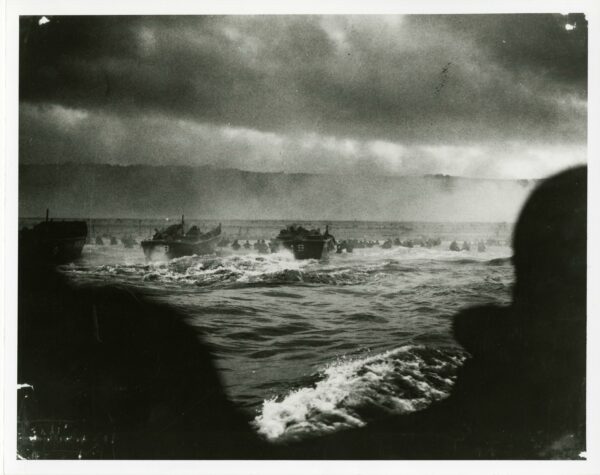
Now, the coxswain started screaming, “Lift up the ramp. Let’s get the hell out of here!” So, I pulled the handle, and the ramp didn’t come up. I pulled it again. Nothing. So now we’re in serious trouble. We’re gonna be target practice for the 88s. I didn’t know what to do. The ramp was in the front and I’m in the back. I can’t see it from where I am because of the dead and wounded in front of me. I had to crawl over them to get to the ramp. And while I’m crawling, I’m crying. I’m saying to these kids, “Please excuse me. I have no other alternative.” When I got closer, I realized that two dead soldiers were on the ramp, holding it down. They never got off the boat. I tried lifting them up, but I couldn’t. I weighed 125 pounds. Another guy came to help and inch by inch, we pulled them into the boat.
Meanwhile, we’re getting fired at. …. Now, the ramp went up and the coxswain started backing out. He did a masterful job avoiding the mines and the Belgian Gates and got us out of there. We had a torturous first wave. It was 90% casualties. It was a bloodbath. We pulled alongside a hospital ship. They would only take the very badly wounded. Two guys, God bless them, jumped in our boat, and started peeling the dead off to get to the live ones underneath. They retrieved seven badly wounded boys and I said, “Maybe they’ll live through the day.”
When we got to our ship, I had a big decision to make. Do I go back? And I said to myself, “Why should I send somebody in my place to be killed?” So, I went back with the second wave. Altogether, I made 15 trips to the beach. They weren’t all bringing troops to the beach. Probably around the sixth or seventh wave, we started taking the dead and the wounded off the beach and back to the ship. We pulled out 308 dead bodies from the water.
By 10 o’clock at night, …. our Higgins boat started going back – it looked like popcorn, all shot up and all the others went back to the Chase. I was covered with blood and vomit and didn’t want to be with anybody. So, I walked to the stern of the ship. It was late. I sat down on the cold deck, and I said to myself, “What the hell just happened here? Why am I still alive?”
And when my eyes got acclimated, I turned around. Against the bulkhead, piled like logs, were all these dead soldiers on top of one another. I started to cry and cried myself to sleep. The next morning, somebody shook me up and said, “Come on. We have to unload the dead.” And that’s what we did. Two people saved my life: Jesus and my mom. The reason I say my mom is that when you’re killed in action, the government sends a telegram. I was determined to live so my mom wouldn’t get that telegram. We were just kids – 17, 18, 19 years old! There were 2,000 boys that were not going see their Mamas. It was by the grace of God I was alive.
After D-Day, we took part in the invasion in southern France and the tail end of Okinawa. I was in the occupation of Japan for about four months and then my service was over. They gave me a check for $84 and a train ticket to go home. When I got back…, I had only a high school diploma. My dad was a chief designer for the Navy for 30 years. He said to me, “Why don’t you follow my footsteps?” So, I became a clothing designer.
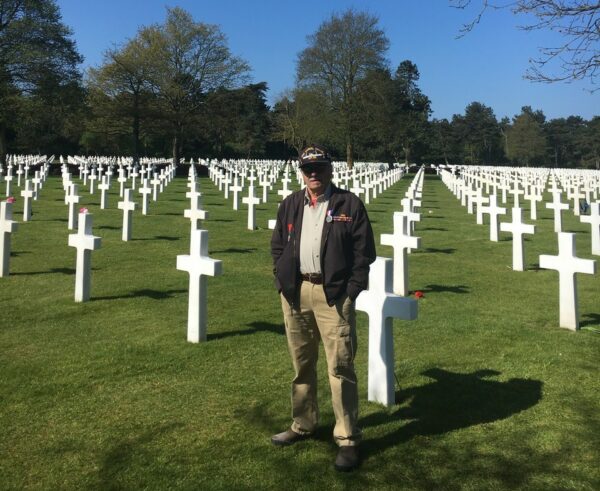
I got married in ’49. Her name was Dorothy …. We had three children – a girl and two boys. For 70 years, I never talked about the war. My wife died six years ago; she never knew. It was too horrible. …. Then, my friend Fred told me, “You gotta talk about it so people know.” He opened up the lock in my brain. The 70th anniversary, five years ago, was the first time I talked about it, when I told the story to Tom Brokaw.
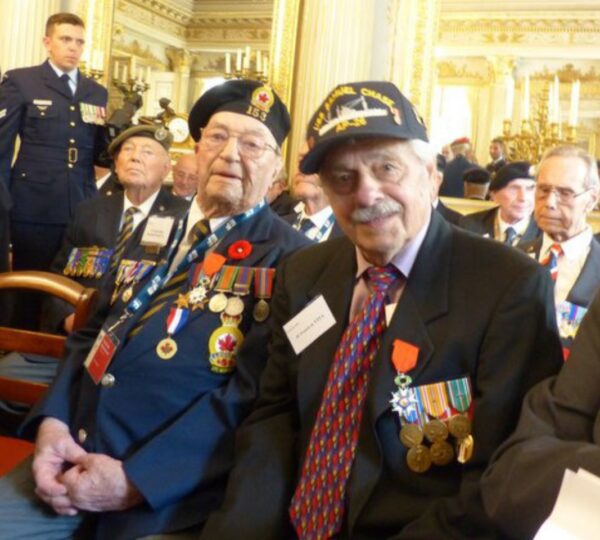
In June I made my 11th trip to Normandy. The beach itself doesn’t affect me that much, but there’s a cemetery right above Omaha Beach with 9,400 dead GIs. I go there every year and I cry, and I cry. They made the biggest sacrifice. They gave their lives so that we have freedom today.
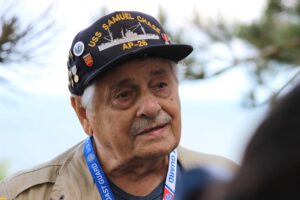
In late 2019, at age 94, with unmatched lucidity and passion, Frank shared his remarkable story with cadets at the U.S. Coast Guard Academy. On March 12, 2020, he passed at his home in Bridgewater, New Jersey. As noted by his family, he never acted or looked his age, even at 96 years old. Frank was laid to rest with full military honors rendered by a Coast Guard Honor Guard at the Prospect Hill Cemetery in Flemington, New Jersey.
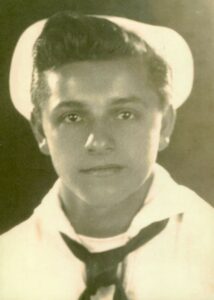
Frank Joseph DeVita defined the word “patriot”, through his heroic actions during World War II and the honorable way he lived his life, devoting his heart and soul during his last 25 years to telling the story of those that fought during World War II, especially those that made the ultimate sacrifice. He was a selfless and courageous Coast Guardsman who embodied the service’s core values of Honor, Respect and Devotion to Duty.
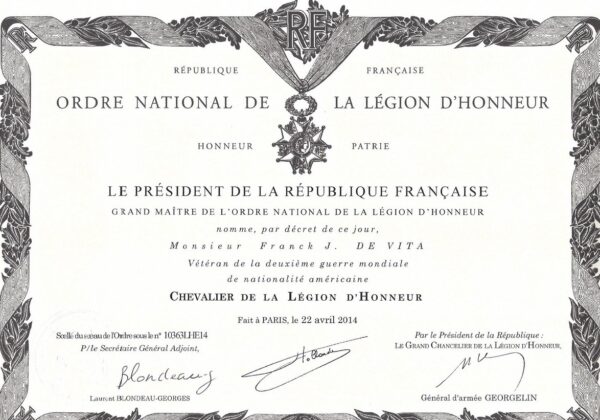
Author’s note: Research disclosed the MG42 machine guns referenced were capable of firing between 1,200 to 1,500 rounds per minute, depending on the ability of German gun squads.
A special note of thanks is extended to the Knights of Columbus, New Haven, Connecticut, for allowing reprint of excerpts from the “To Hell and Back” story that appeared in the June 2019 issue of Columbia magazine. Special thanks also to Richard D. DeVita, Esq., the youngest son of Frank and Dorothy DeVita, for his invaluable assistance in my research for this piece.
National Coast Guard Museum insider tip: The Coast Guard’s vital role in World War II, from Atlantic convoys to the D-Day landings and beyond, will be covered in the exhibit in the Defenders of our Nation wing on Deck 03 of the museum.
